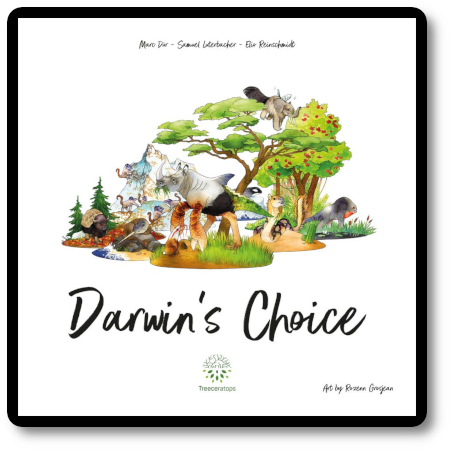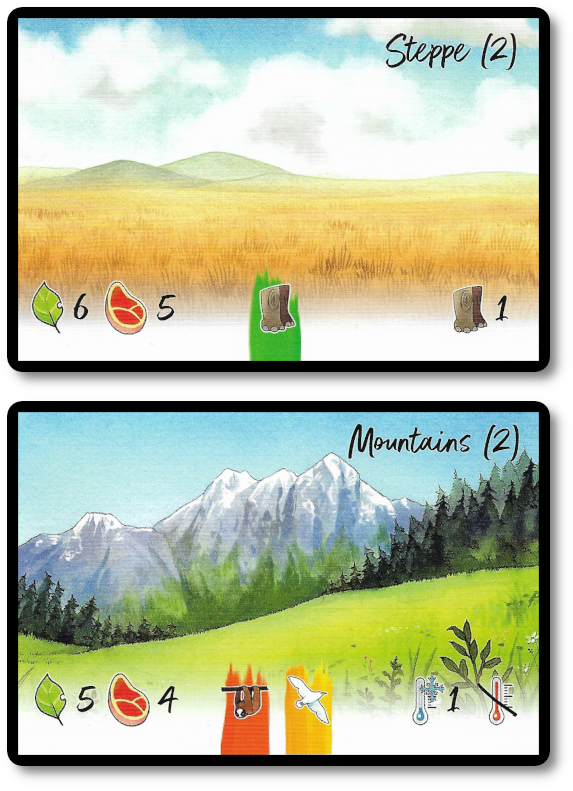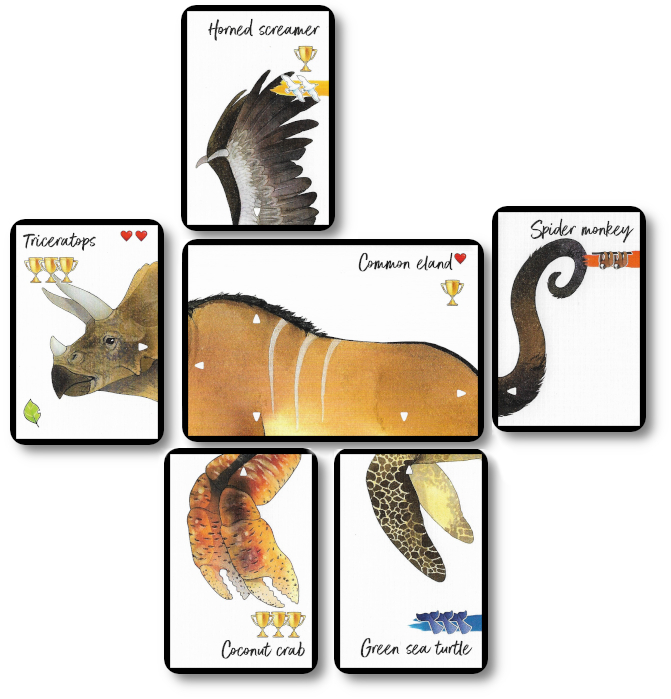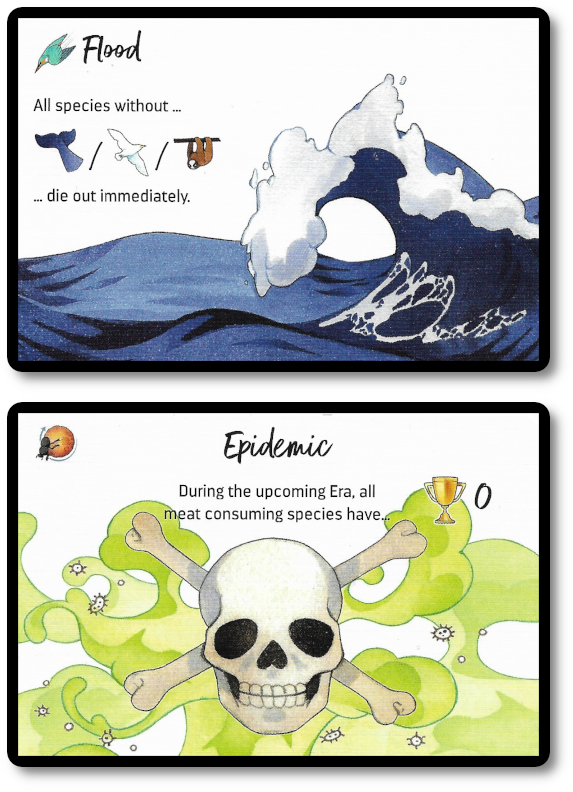
The Basics:
- For 2 to 6 players
- For ages 14 and up (publisher suggests 10+)
- Approximate 120 minutes to complete
Geek Skills:
- Active Listening & Communication
- Counting & Math
- Logical & Critical Decision Making
- Reading
- Pattern/Color Matching
- Strategy & Tactics
- Risk vs. Reward
- Cooperative & Team Play
- Hand/Resource Management
- Trading
Learning Curve:
- Child – Moderate
- Adult – Easy
Theme & Narrative:
- Survival of the “weirdest”
Endorsements:
- Gamer Geek mixed!
- Parent Geek mixed!
- Child Geek mixed!
Overview
English naturalist, geologist and biologist, Charles Darwin, said about his theory on the survival of the fittest, “I have called this principle, by which each slight variation, if useful, is preserved, by the term of Natural Selection.” In this game, players will introduce new and wonderous animal species, mutating them to adapt to shifting climates in hopes of keeping them alive for as long as possible. What players will quickly learn that no matter how strong an animal might be, it will not be able to survive unless it has the capability of changing.
Darwin’s Choice, designed by Marc Dür, Samuel Luterbacher, Elio Reinschmidt and published by Treecer, is comprised of 16 Event cards, five Continental cards, 12 Overview cards, 237 Animal cards, 22 Biome cards, six Competition chips, five Continental chips, 102 Darwin points (in the values of one, five, and ten), one “First Player” marker, 62 Food chips, and 72 Player markers. The cards are as thick and as durable as your standard playing card, and the chips and markers are made of thick cardboard. Illustrations by Rozenn Grosjean are bright and colorful, adding visual flair to the animals the players’ mix and match.
Prepping for Life
To set up the game, first designate one of the players the “Game Master.” This role requires the player to moderate some of the gameplay and calculate scores. As such, it should be assigned to experienced players at first, with new players learning about the role as the game progresses.
Second, give each player all the Player Markers of the color of their choice (or randomly disperse the colors to keep things moving along) and two Overview cards.
Third, shuffle the Animal cards, Event cards, Continental cards, and Biome cards into their decks and place face-down in the middle of the game playing area where all players can easily reach them. Place the Food chips, Competition chips, and Darwin Points in sorted piles next to the card decks, as well.
Fourth, draw several Biome cards as determined by the number of players in the game, placing them face-up above and below the decks of the face-down cards. Place one Continental chip above each face-up Biome card at this time.

Fifth, place the indicated number and type of Food chip quantities as defined by the face-up Biome cards.
Sixth, each player draws 10 Animal cards as their starting hand. The Animal cards can be drawn from either of the two Animal card decks, giving the player the ability to mix and match. Players can look at the cards they draw before continuing to draw more.
This completes the game set up. The Game Master is given the “First Player” marker, and the game begins.
A Game of Survival and Manipulation
Darwin’s Choice is played in turns and rounds for a total of four rounds per game. Each round is referred to as an “Era.” Each Era (round) is comprised of three phases, which are summarized here.
Phase One: Action
The Action phase introduces new animal species that can be combined and mutated, as well as giving the animals a chance to move to more hospital biomes. This phase has three main actions that the players must take and two additional actions which are optional. Players can only take one Main Action per animal species in each Era. That is to say, an animal can be created, mutated, or migrated, but not a mix of two or more. Use the Player Markers to help identify what animals have taken actions.
Note: If a player is unable to create an animal using their Animal cards in their hand in the first Era, they can discard all their Animal cards and draw 10 new Animal cards. This is repeated until the player can create at least one animal and only after all ten cards are drawn.
Additional Action One: Redraw Cards
At the start of each Era (and only once per Era), players may keep their 10 Animal cards or discard all but one, allowing them to draw another nine. This Additional Action is only available to the player as their first action for their turn. It should be noted that nothing stops a player from discarding their Animal cards in their hand anytime during the Era, even if it isn’t the player’s turn.
Additional Action Two: Trade Cards
During the player’s turn, they may trade Animal cards in their hand with their opponents. A player can never have any more than 10 Animal cards in their hand at a time. During the trade, the trading partners get to see all the Animal cards being traded (i.e., “no blind trades”), but the cards being traded or discussed as a trade should be made invisible to any player not participating in the trade. Only players and opponents who have not “passed” (remaining active in the Era) can be traded with.
Main Action One: Create
To create a new animal species, the player places one of their Animal cards in one of the available Biome cards. The “Head” Animal card indicates the number and type of food that must be available for the animal to live in the biome. The matching Food chips are first taken from the supply above the Biome card. If there are no Food chips, they are instead fed from previously played Animal cards with a lower Adaption value.
To put it another way, new Animal cards can only be placed to a biome if the food exists to keep them thriving. The first animals to arrive at a biome will have their pick of the food. As new animals come and food resources dwindle, the animals who are eating the Food chips become the food for new animals. Ah, the circle of life…
An animal is comprised, at most, of a “Head,” a “Body,” two pairs of “Legs,” one set of “Wings,” and one “Tail” (for a total of six Animal cards). When placing the Animal cards, the names noted on the cards must align horizontally. It should also be noted that new animals created need not be complete. That is to say, they can be missing legs, but must have, at minimum, a “Head” and “Body.” Once played, however, the animal is done. Players only get to create it once. When built, the player adds their Player marker to it, indicating it is their animal.

Main Action Two: Mutate
OK, I lied.
Yes, players must play their entire animal they create during one turn. But, through the awesome power of mutation, players can adjust the animal. A minimum of one and a maximum of two mutations are possible per animal species that the player owns. Additionally, finished mutated animals must still be able to survive in the biome.
Mutations include:
- Removing an Animal card from the species without replacing it
- Adding an Animal card to the species if there is a free space (for example, the player could add “Wings” if the animal species does not currently have any wings)
- Replace (swap-out) one Animal card with a similar Animal card (for example, a “Head” Animal card with another “Head” Animal card).
Mutating an animal species once is free, but if the player mutates the species again, it’s referred to as a “Double Mutation.” The player must pay for such a privilege using Darwin Points.
Removed and replaced Animal cards are discarded to their matching discard pile.
Main Action Three: Migrate
Eventually, an animal species will need to migrate to a new location or starve to death. The player does this by picking up their animal species from its current Biome card location and placing it to a new Biome card location. Any Food chips and Continental chips belonging to the animal species remain attached to the original Biome card. If the animal species cannot survive in the new Biome card (it doesn’t have the right number and type of Food chips available), the animal species are unable to migrate.
Once the player takes their main action and any of the optional actions, their turn is over, and the next player takes their turn. During this phase, players can decide to “pass” if they do, they no longer get to participate in the phase. The phase ends once all players have passed.
Phase Two: Evaluation
This phase has five steps and is lead by the Game Master.
Step One: Check Animal Species Requirements
With the help of the other players, the Game Master checks to see which animal species in play meet the requirements of the Biome cards they are attached to. Any animal species that do not match immediately die. Dead animal species are taken from the Biome card, and the cards are returned to their matching discard piles. Player markers are returned to their owner, and one Darwin Point is awarded if the animal species had one or more Darwin Points assigned to it when it passed away. Any other Darwin Points are lost and returned to the supply.
Step Two: Evaluate Food
Again, with the help of the other players, the Game Master evaluates each of the surviving animal species to determine if they can be fed. Animal species will either eat the food provided, eat other animal species, or die out. Evaluate all herbivores and omnivores first, followed by carnivores.
Dead animal species are discarded.
Step Three: Survival of the Fittest
Each animal species still in the game is now awarded one Darwin Point.
Step Four: Adapt or Die
Each Biome is now evaluated to determine which of the attached animal species is the most adaptable, with the winner being assigned the biome’s Continental chip. The number of Darwin Points awarded is equal to the number indicated on the Biome card. If there is a tie, the Competitive Strength values of the animal species are compared, with victory going to the more aggressive. An animal species with no adaption is never awarded Darwin Points.
Step Five: Strength of a Species
The Game Master now evaluates all of the Biomes and identifies the top three animal species that are the strongest using the animal species’ Competitive Strength values. The Competition chips are awarded in the order of the animal species placing, with three Darwin Points going to the first place, two going to the second, and one going to the third.
Phase Three: Transition
The Era is now coming to an end. Seven steps must be completed in sequential order.
- All Event cards played in this Era are discarded. A new Event card is then drawn, placed face-up, and activated. Event cards will be resolved either immediately (one time impact) or will be in play for the duration of the next Era (permanent).

- A new defined number of Biome cards are drawn and assigned, replacing Biome cards they displace. The number of biomes changed is dependent on the number of players in the game and the Era being played.
- Food is redistributed per the new conditions indicated on the Biome cards. The Food chips are then assigned to the animal species per their Adaption.
- All Player markers are reset.
- If playing with a Trade Zone, the animal cards within are discarded and replaced.
- Each player replenishes their hand for a maximum of 10 Animal cards. Unplayed Animal cards in the player’s hand are not discarded.
- The First Player marker is moved to the next player in turn order sequence.
This completes the Era. A new Era now begins as noted with phase one above.
The End of All Eras
The game ends after phase two (Evaluation) of the final Era. All players count the number of Darwin Points they have earned through extinction and living animal species still in play. The player with the most Darwin Points wins the game.
Game Variants
There are a few game variants available. They are summarized here.
Evolution is Child’s Play
This game variant is an exceedingly watered-down version of the base game summarized above, challenging the players to put together an animal species that meet the requirements of the Biome cards in play but takes no consideration of the food that would usually be required for the animal species to survive. A perfectly legit and fun way to play Darwin’s Choice with your Child Geeks, giving the game more time at your family gaming table.
Survival for Beginners
The base game described above includes a lot of resource management and strategic thinking. This can be overwhelming to new and inexperienced players. The beginner’s game is meant to reduce the number of choices available to the player and rules, but at the same time, takes their hand and instructs as the game progresses.
A World for Two
Darwin’s Choice is best played with three to four players, but if you only have two at the table, the game can be played with a few rule changes. Cards are removed from play, and a Trade Zone is provided, giving players the option always to adjust the cards in their hand.
Cooperative Survival
This game version lets players join together with a partner to create two teams of two. Each team is trying to win as usual, but players work together as a team to ensure their animal species survive.
To learn more about Darwin’s Choice, visit the game’s web page.
Final Word
 The Child Geeks were lost for the first game but quickly found their footing in the second and subsequent games. What it came down to was the patience of the Child Geeks. If they had a lot of it, they did great. If they started to lose interest, the game suddenly became a painful chore. According to one Child Geek who has an elitist’s gaming stamina, “I like the game a lot. I can build lots of different animals, adjusting to the changing conditions. I think the best part of the game is how much control you think you have.” Another Child Geek who didn’t find the game entertaining said, “The game feels like work. I didn’t have any fun because my animals always died. I couldn’t feed them, or I couldn’t get the right cards.” When all the votes were in, the Child Geeks gave Darwin’s Choice a mixed review.
The Child Geeks were lost for the first game but quickly found their footing in the second and subsequent games. What it came down to was the patience of the Child Geeks. If they had a lot of it, they did great. If they started to lose interest, the game suddenly became a painful chore. According to one Child Geek who has an elitist’s gaming stamina, “I like the game a lot. I can build lots of different animals, adjusting to the changing conditions. I think the best part of the game is how much control you think you have.” Another Child Geek who didn’t find the game entertaining said, “The game feels like work. I didn’t have any fun because my animals always died. I couldn’t feed them, or I couldn’t get the right cards.” When all the votes were in, the Child Geeks gave Darwin’s Choice a mixed review.
 The Parent Geeks, like the Child Geeks, had mixed feelings. For those Parent Geeks who enjoyed a beefier game full of different options, twists, and turns, Darwin’s Choice was a natural selection. For those Parent Geeks who did not….well. According to one such Parent Geek, “Just horrible. Lack of table space and lack of game speed made this game feel like it was all work and no play. I spent more time trying to figure out how to build my animals using very little table space rather than building the perfect animal species to survive the apocalypse.” A Parent Geek who rather enjoyed Darwin’s Choice had a different take. “I’ve played other games where you evolve animals, and I liked this one the best. Lots of choices and lots of different ways to adapt. I felt like I was adapting and mutating my animals, making each turn feel very involved and rewarding.” When all the votes were in, the Parent Geeks gave Darwin’s Choice a mixed review, too.
The Parent Geeks, like the Child Geeks, had mixed feelings. For those Parent Geeks who enjoyed a beefier game full of different options, twists, and turns, Darwin’s Choice was a natural selection. For those Parent Geeks who did not….well. According to one such Parent Geek, “Just horrible. Lack of table space and lack of game speed made this game feel like it was all work and no play. I spent more time trying to figure out how to build my animals using very little table space rather than building the perfect animal species to survive the apocalypse.” A Parent Geek who rather enjoyed Darwin’s Choice had a different take. “I’ve played other games where you evolve animals, and I liked this one the best. Lots of choices and lots of different ways to adapt. I felt like I was adapting and mutating my animals, making each turn feel very involved and rewarding.” When all the votes were in, the Parent Geeks gave Darwin’s Choice a mixed review, too.
 The Gamer Geeks all agreed that Darwin’s Choice was a game with a good deal of depth and potential. From there, they parted way. As one Gamer Geek put it, who enjoyed the game, “Yes, this is the stuff right here. Tough choices, ever-shifting landscape, new opportunities to take advantage of, and ball-breaking disappointment at the drop of a hat. I always felt like I was on the edge of my seat and enjoyed watching the choices being made by my opponents.” Another Gamer Geek who felt very differently said, “My God, this game is fiddly. I felt like I was playing a game full of switches and knobs. And when those random events come out and poop all over you – yeah – not great. I won’t be playing this game again.” When all the votes were counted, the Gamer Geeks also gave Darwin’s Choice a mixed review.
The Gamer Geeks all agreed that Darwin’s Choice was a game with a good deal of depth and potential. From there, they parted way. As one Gamer Geek put it, who enjoyed the game, “Yes, this is the stuff right here. Tough choices, ever-shifting landscape, new opportunities to take advantage of, and ball-breaking disappointment at the drop of a hat. I always felt like I was on the edge of my seat and enjoyed watching the choices being made by my opponents.” Another Gamer Geek who felt very differently said, “My God, this game is fiddly. I felt like I was playing a game full of switches and knobs. And when those random events come out and poop all over you – yeah – not great. I won’t be playing this game again.” When all the votes were counted, the Gamer Geeks also gave Darwin’s Choice a mixed review.
 The game has three flaws, in my opinion. First, scoring takes a lot longer than you’d want. The fact that there is a designated “Game Master” with the role of adding up the points should tell you right off the bat that this game requires number crunching and a heavy amount of evaluation. Counting points is not a quick exercise.
The game has three flaws, in my opinion. First, scoring takes a lot longer than you’d want. The fact that there is a designated “Game Master” with the role of adding up the points should tell you right off the bat that this game requires number crunching and a heavy amount of evaluation. Counting points is not a quick exercise.
Second, the game takes up a lot of space, and may the gaming gods help you if you bump the table, redistributing the chips and cards in play. The game feels unnaturally heavy at times and a bit convoluted. The pacing drags during scoring and finding table space becomes a challenge. Adding fuel to the fire, the game is the most interesting when you have all the players. Which, again, means you need a lot of table space and a very patient Game Master to keep score. I won’t even go into detail about how much “fun” it’s to migrate animal species when you have a gaming table way too full of game components.
The game’s third and final flaw is the Events. They are unneeded and unwarranted. The game is already complicated enough and does not require random outcomes and adjustments to make the game any more difficult or entertaining. It felt like too much icing on an already too big a cake.
And that does it for the negative, which is outweighed by the game’s many positives. For starters, this game is exceedingly exciting to work out in your head. There are a seemingly endless number of ways to build your animal species, countless ways to adjust, and a good deal of flexibility to test your strategic and tactical muscle. Expect a good deal of “vapor locking” with new players as they work out the many different ways they could help their animal species survive or die spectacularly. And what animals they are! Chickens with whale tails, chimps with spider legs! It’s all here and marvelous to look at. You’ll laugh a good deal as the game progresses as some of the animal species that are created are ridiculous.
Darwin’s Choice is not everyone’s first choice..or second, as the endorsements clearly show. Players either really enjoyed it or didn’t. As it turns out, the deciding factor for many of our players was their love (or lack thereof) of the game, Evolution. Players who wanted a more significant, grittier version were naturally drawn to and enjoyed Darwin’s Choice. For those who liked the more straightforward and more direct playing style found in Evolution, Darwin’s Choice was seen as a mess. To me, this indicates that you’ll either enjoy or dislike Darwin’s Choice if you enjoy games that allow you to do a lot of tinkering. Keep in mind, however, that “tinkering” can quickly shift to “fiddly.” More choices and chances mean more opportunities to get bored and lost.
I rather enjoyed the game and would recommend it to players who are looking for a game with lots of choices and many different surprising outcomes. The game has its flaws, but I’ve played only a few games in my life that I would ever consider “perfect.” What Darwin’s Choice does wrong is balanced by what it does right. Super rules-heavy with an unlimited amount of replayability. Do give this game a try to see if it survives your evaluation.
This game was given to Father Geek as a review copy. Father Geek was not paid, bribed, wined, dined, or threatened in vain hopes of influencing this review. Such is the statuesque and legendary integrity of Father Geek.




Love this writeup and the overall categories and style!